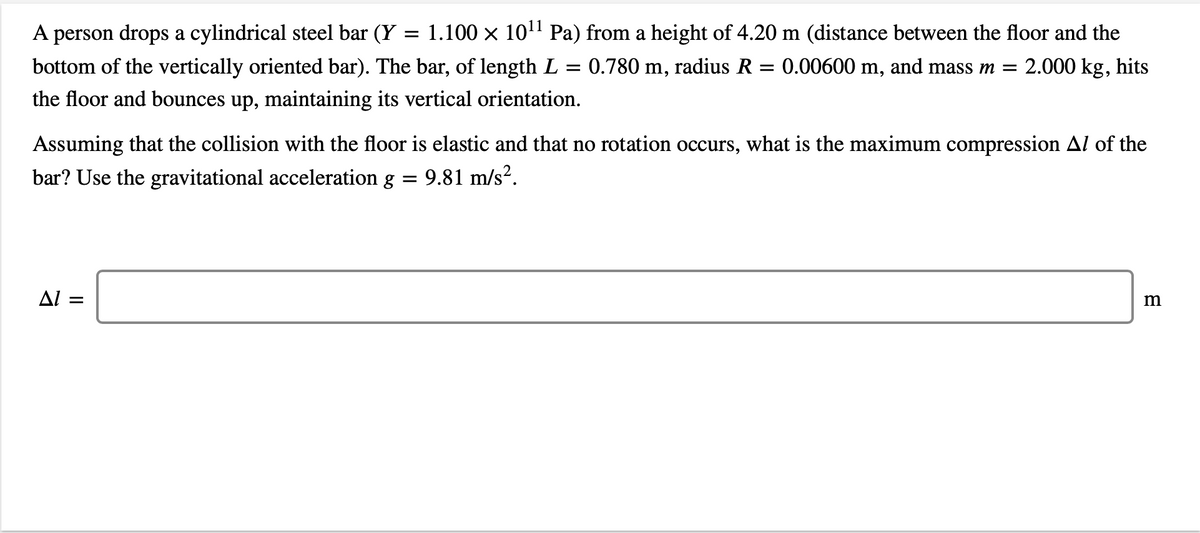A person drops a cylindrical steel bar (Y = 1.100 × 101' Pa) from a height of 4.20 m (distance between the floor and the bottom of the vertically oriented bar). The bar, of length L = 0.780 m, radius R = 0.00600 m, and mass m = 2.000 kg, hits the floor and bounces up, maintaining its vertical orientation. Assuming that the collision with the floor is elastic and that no rotation occurs, what is the maximum compression Al of the bar? Use the gravitational acceleration g = 9.81 m/s?.
A person drops a cylindrical steel bar (Y = 1.100 × 101' Pa) from a height of 4.20 m (distance between the floor and the bottom of the vertically oriented bar). The bar, of length L = 0.780 m, radius R = 0.00600 m, and mass m = 2.000 kg, hits the floor and bounces up, maintaining its vertical orientation. Assuming that the collision with the floor is elastic and that no rotation occurs, what is the maximum compression Al of the bar? Use the gravitational acceleration g = 9.81 m/s?.
Physics for Scientists and Engineers, Technology Update (No access codes included)
9th Edition
ISBN:9781305116399
Author:Raymond A. Serway, John W. Jewett
Publisher:Raymond A. Serway, John W. Jewett
Chapter6: Circular Motion And Other Applications Of Newton’s Laws
Section: Chapter Questions
Problem 6.8P: Consider a conical pendulum (Fig. P6.8) with a bob of mass m = 80.0 kg on a string of length L =...
Related questions
Question
12) A person drops a cylindrical steel bar (?=1.100×1011 Pa) from a height of 4.20 m (distance between the floor and the bottom of the vertically oriented bar). The bar, of length ?=0.780 m, radius ?=0.00600 m, and mass ?=2.000 kg, hits the floor and bounces up, maintaining its vertical orientation.
Assuming that the collision with the floor is elastic and that no rotation occurs, what is the maximum compression Δ? of the bar? Use the gravitational acceleration ?=9.81 m/s2.

Transcribed Image Text:A person drops a cylindrical steel bar (Y
= 1.100 x 10'" Pa) from a height of 4.20 m (distance between the floor and the
bottom of the vertically oriented bar). The bar, of length L =
:0.780 m, radius R =
0.00600 m, and mass m = 2.000 kg, hits
the floor and bounces up, maintaining its vertical orientation.
Assuming that the collision with the floor is elastic and that no rotation occurs, what is the maximum compression Al of the
bar? Use the gravitational acceleration g
9.81 m/s?.
Expert Solution
This question has been solved!
Explore an expertly crafted, step-by-step solution for a thorough understanding of key concepts.
This is a popular solution!
Trending now
This is a popular solution!
Step by step
Solved in 3 steps

Knowledge Booster
Learn more about
Need a deep-dive on the concept behind this application? Look no further. Learn more about this topic, physics and related others by exploring similar questions and additional content below.Recommended textbooks for you

Physics for Scientists and Engineers, Technology …
Physics
ISBN:
9781305116399
Author:
Raymond A. Serway, John W. Jewett
Publisher:
Cengage Learning

University Physics Volume 1
Physics
ISBN:
9781938168277
Author:
William Moebs, Samuel J. Ling, Jeff Sanny
Publisher:
OpenStax - Rice University

Classical Dynamics of Particles and Systems
Physics
ISBN:
9780534408961
Author:
Stephen T. Thornton, Jerry B. Marion
Publisher:
Cengage Learning

Physics for Scientists and Engineers, Technology …
Physics
ISBN:
9781305116399
Author:
Raymond A. Serway, John W. Jewett
Publisher:
Cengage Learning

University Physics Volume 1
Physics
ISBN:
9781938168277
Author:
William Moebs, Samuel J. Ling, Jeff Sanny
Publisher:
OpenStax - Rice University

Classical Dynamics of Particles and Systems
Physics
ISBN:
9780534408961
Author:
Stephen T. Thornton, Jerry B. Marion
Publisher:
Cengage Learning

Physics for Scientists and Engineers: Foundations…
Physics
ISBN:
9781133939146
Author:
Katz, Debora M.
Publisher:
Cengage Learning

Physics for Scientists and Engineers with Modern …
Physics
ISBN:
9781337553292
Author:
Raymond A. Serway, John W. Jewett
Publisher:
Cengage Learning

Physics for Scientists and Engineers
Physics
ISBN:
9781337553278
Author:
Raymond A. Serway, John W. Jewett
Publisher:
Cengage Learning